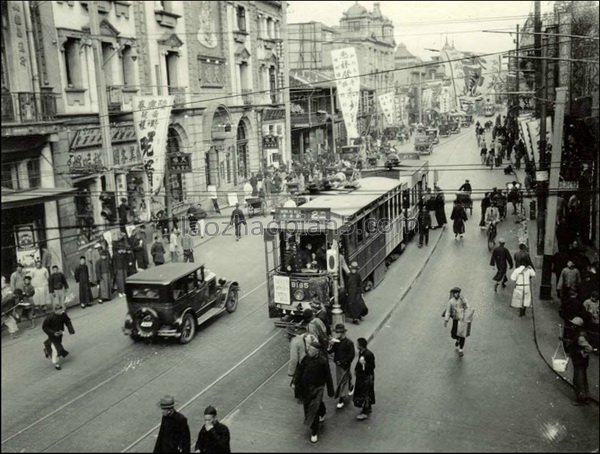Period:Ming dynasty Production date:1610 (dated)
Materials:porcelain
Technique:glazed, incised,
Subjects:deity symbol
Dimensions:Height: 26.50 centimetres
Description:
‘Blanc de Chine’ porcelain figure of a popular god with transparent glaze. This ‘blanc de Chine’ figure shows the deity seated on a throne with a faceted base, holding his left hand out in front of him and clasping a pearl and resting his right hand on his upper set of belt plaques. He is portrayed as a middle-aged man and dressed in official dragon robes over armour and boots which are just visible. The front of his costume is incised to evoke a badge of rank with a prancing dragon, a motif which is also incised lower down the robe in the skirt. On his head he wears a crown with mantling. His eyes are cast down in a respectful attitude and there are holes above his mouth for the attachment of real hair whiskers to lend the god greater reality. The base is littered with auspicious symbols of wealth such as paired rhinoceros horns. The figure is deeply carved and is covered with a yellow-tinged glaze. On the back of the throne, the figure is incised with a fifteen-character inscription written in three parallel vertical lines. This gives the time and date of manufacture of the figure.
IMG
![图片[1]-figure BM-1930-1113.1-China Archive](https://chinaarchive.net/Ming dynasty/Ceramics/mid_00030559_001.jpg)
![图片[2]-figure BM-1930-1113.1-China Archive](https://chinaarchive.net/Ming dynasty/Ceramics/mid_00091004_001.jpg)
![图片[3]-figure BM-1930-1113.1-China Archive](https://chinaarchive.net/Ming dynasty/Ceramics/mid_00255514_001.jpg)
Comments:Harrison-Hall 2001:The style of modelling, clay and quality of decoration are consistent with its inscription. Such fine-quality heavily potted figures were made only at the Dehua kilns in the first half of the seventeenth century, during the late Ming era. Qing figures are stylistically quite different and lack such depth of carving and attractive warm glaze.Identification of the figure is problematical. Donnelly classified the figure as Cai Shen, God of Wealth. He notes that Cai Shen was based on a historical figure, Zhao Gongming, of the Zhou period, and holds an ingot in one hand. However the figure may be a representation of Guandi, the popular God of War, who by the late Ming period was also God of Wealth (see BM 1938.0524.27). Stuart 2009: Author Liu Youzheng writing in 2007 identifies the figure as Guandi.
Materials:porcelain
Technique:glazed, incised,
Subjects:deity symbol
Dimensions:Height: 26.50 centimetres
Description:
‘Blanc de Chine’ porcelain figure of a popular god with transparent glaze. This ‘blanc de Chine’ figure shows the deity seated on a throne with a faceted base, holding his left hand out in front of him and clasping a pearl and resting his right hand on his upper set of belt plaques. He is portrayed as a middle-aged man and dressed in official dragon robes over armour and boots which are just visible. The front of his costume is incised to evoke a badge of rank with a prancing dragon, a motif which is also incised lower down the robe in the skirt. On his head he wears a crown with mantling. His eyes are cast down in a respectful attitude and there are holes above his mouth for the attachment of real hair whiskers to lend the god greater reality. The base is littered with auspicious symbols of wealth such as paired rhinoceros horns. The figure is deeply carved and is covered with a yellow-tinged glaze. On the back of the throne, the figure is incised with a fifteen-character inscription written in three parallel vertical lines. This gives the time and date of manufacture of the figure.
IMG
![图片[1]-figure BM-1930-1113.1-China Archive](https://chinaarchive.net/Ming dynasty/Ceramics/mid_00030559_001.jpg)
![图片[2]-figure BM-1930-1113.1-China Archive](https://chinaarchive.net/Ming dynasty/Ceramics/mid_00091004_001.jpg)
![图片[3]-figure BM-1930-1113.1-China Archive](https://chinaarchive.net/Ming dynasty/Ceramics/mid_00255514_001.jpg)
Comments:Harrison-Hall 2001:The style of modelling, clay and quality of decoration are consistent with its inscription. Such fine-quality heavily potted figures were made only at the Dehua kilns in the first half of the seventeenth century, during the late Ming era. Qing figures are stylistically quite different and lack such depth of carving and attractive warm glaze.Identification of the figure is problematical. Donnelly classified the figure as Cai Shen, God of Wealth. He notes that Cai Shen was based on a historical figure, Zhao Gongming, of the Zhou period, and holds an ingot in one hand. However the figure may be a representation of Guandi, the popular God of War, who by the late Ming period was also God of Wealth (see BM 1938.0524.27). Stuart 2009: Author Liu Youzheng writing in 2007 identifies the figure as Guandi.
© Copyright
The copyright of the article belongs to the author, please keep the original link for reprinting.
THE END




![[Qing Dynasty] British female painter—Elizabeth Keith, using woodblock prints to record China from the late Qing Dynasty to the early Republic of China—1915-China Archive](https://chinaarchive.net/wp-content/uploads/2022/11/image-191x300.png)
